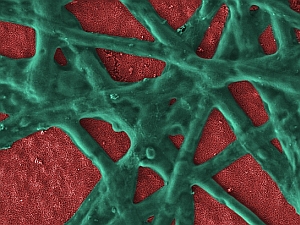
Hematite nanoparticle film in red, with functional phycocyanin network, in green, attached. (E. Vitol, Argonne National Laboratory
Researchers from the Swiss research institute Empa, University of Basel in Switzerland, and Argonne National Laboratory near Chicago have developed electrodes made from algal protein that mimic a key process in photosynthesis used to directly generate hydrogen from water. The team describes their findings in the online issue of the journal Advanced Functional Materials (paid subscription required).
The process of photosynthesis serves as a model for renewable fuel production, because it directly converts solar energy into hydrogen, a storable fuel, using only water and carbon dioxide. Up to now, developing a renewable energy source with this model has required using photo-electrochemical cells (PECs) made of semiconducting materials such as metal oxides, notably iron oxide and titanium dioxide.
The Swiss-American team has produced a biological-based PEC electrode using nanotechnology consisting of iron oxide combined with a protein from blue-green algae that they say is twice as efficient in electrochemical water splitting as iron oxide alone. The electrode uses a low cost and abundant type of iron oxide called hematite that can absorb a wider visible spectrum than titanium dioxide, and thus uses sunlight more efficiently.
The second ingredient in the electrode is the protein phycocyanin derived from blue-green algae, also known as cyanobacteria. Debajeet Bora who designed the new electrode as part of his doctoral research at Empa captured what he calls “the natural photosynthetic machinery of cyanobacteria where phycocyanin acts as a major light-harvesting component.”
With his colleagues, Bora cross-coupled phycocyanin to hematite nanoparticles that had been immobilized as a thin film. The resulting hybrid algal-protein/hermatite absorbed many more photons than iron oxide alone, giving an electrode with twice the photocurrent than a plain iron oxide electrode.
One surprising outcome of the research was the ability of the light-harvesting proteins to survive while in contact with with a photocatalyst in an alkaline environment under strong illumination. Artur Braun, a group leader in Empa’s high-performance ceramics lab and the study’s principal investigator, notes that “Photocatalysts are designed to destroy organic pollutants,” but in this case, “There seems to be a delicate balance where organic molecules not only survive harsh photocatalytic conditions, but even convey an additional benefit to ceramic photocatalysts: They double the photocurrent.”
Read more: Netherlands to Open Bio-Solar Research, Production Center
* * *

 RSS - Posts
RSS - Posts
[…] Algae Protein Electrodes Boost Photosynthesis Process […]